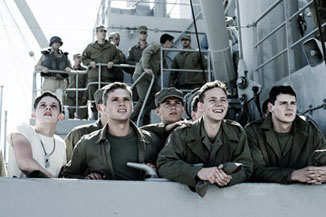Flags of Our Fathers: DVD Review
By D. James Ruccio III
February 6, 2007
Flags of Our Fathers is director Clint Eastwood's, attempt at telling the story of the flag raising during the early days of the invasion of Iwo Jima in World War II and the effects of the iconic photo on those involved. The movie unfortunately does not meet the challenge of equaling the power of that simple, beautiful photo. That is not to say that it fails, it simply attempts too much.
Flags of Our Fathers is the story of the three remaining survivors, Ira Hayes ( Adam Beach), John "Doc" Bradley ( Ryan Phillippe) and Rene Gagnon (Jesse Bradford), of the island invasion who hoisted the American flag atop Mt. Surabachi and were immortalized in one of the most memorable photos taken in all of photography.
Told in a non linear fashion with a series of flash backs and multiple timelines, it is an extremely complex movie for even the most enthusiastic audience to follow. It attempts to address the multiple themes of survivor's guilt, the definition of heroism, the purpose of information and propaganda in war and finally, racism. In attempting to explore all these ideas it unfortunately never gives each its due.
Ira Hayes, played outstandingly by Adam Beach, is the most fully realized character and the one presented with the most emotional depth. In this character, the story explores the crushing guilt of surviving a battle. He stoically accepts the duty of attending the War Bond Drive used to capitalize on the photo's success throughout until he meets the mother of his dead best friend. In that scene, Beach's performance not only portrays the guilt he possesses but displays his need for solace from someone else. He collapses into her arms and accepts her maternal comfort in one of the movie's most powerful moments.
The Hayes character is also tasked with taking on another theme of the film, racism. Constantly called "Chief" in reference to his Native American heritage, he is subjected to prejudices throughout the movie. Here, too, the film never really seems to say much, although to be fair, perhaps the intent was simply to show another aspect of the complex torments that haunted Ira Hayes.
Oddly, neither Phillippe nor Bradford's characters are written with the same intensity. Each of the three characters express doubt as to their own heroism and constantly softly deflect the praise unto the people they say are the more deserving - those who perished. However, their characters contribute peripherally to the rest of the story but otherwise remain subordinate to Ira Hayes. Many of the other characters are written thinly and serve the story only as caricatures.
The movie also attempts to explore the purpose of propaganda in warfare and the use of information as a tool. "We need easy to understand truths and damn few words" a character says. The idea that the picture was staged, a quiet rumor of the time (owing most likely to the fact that the picture captured the second, larger flag being raised) is a subtle question relevant perhaps given today's current conflict. But again it fights for importance throughout the script.
All of these competing ideas are made that much harder to comprehend with the story, which is told in a series of flashbacks spanning three timelines. This leads to much confusion throughout and again hampers the movie's execution. It is not even clear until the last third of the movie that this story is being told to the son of one of the flag raisers. The audience is often left wondering why the flashback occurs and which of the themes it applies to.
The movie, however, does do several things right. Even with all the damage these events have done to the soldiers, Clint Eastwood never strays from the idea that the cause of the war and the implementation of it was correct. The characters, while damaged - some fatally - are presented as just and tragic figures. They accepted the responsibility of their experiences and the more damaging effects upon their lives.
The battle scene is visceral and effective in communicating the terror of combat, (although it suffers in the inevitable comparison to the opening battle sequence of Saving Private Ryan). The island itself is presented as an enemy. In fact, we don't see much of the Japanese defenders, just their weapons slowly advancing through the narrow firing slits from behind their defensive fortifications. The idea culminates with several shots of American naval, air and land forces assaulting Mt. Surabachi itself. It is a powerfully menacing concept. These scenes give the audience a sense of the titanic forces set to clash and are equal to the movies numerous themes.
The score, with works from Clint Eastwood himself, at the end is quiet and poignant.
Ultimately, Flags of Our Fathers defeats itself with its storytelling decisions. Perhaps on subsequent viewings, however, out of respect for Clint Eastwood's directorial ability and the subject matter, its complexity will become a virtue. Also, perhaps the movie's companion piece, Letters from Iwo Jima, will better realize his overall purpose.




